List of Hitches Knots
How to Tie Rope Hitches | Rope Hitches
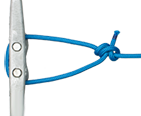
Midshipman's Hitch : The Midshipman's (Taut Line) Hitch is an adjustable loop and can be used for tying Spring Lines.

Anchor Hitch: The Anchor Hitch - or Fisherman's Hitch - is suitable to attach a line to an anchor. It is like a Round Turn and Two Half Hitches with the first Half Hitch passed under the first round turn. Add one or more Half Hitches for security

Klemheist: The Klemheist is a Slide and Grip (friction) knot related to the original Prusik knot but designed to take strain in only one direction. When loaded it grips the climbing rope; with the load released it can easily be slid up or down.
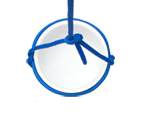
Barrel Hitch The Barrel Hitch provides a secure method of lifting of barrels, buckets and other containers.
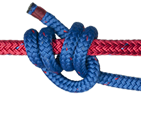
Blake's Hitch: Blake's hitch is a Slide and Grip (friction) Hitch designed to take strain in only one direction. It is used by arborists for ascent and descent. It has some tendency to loosen and slip.

Boom Hitch: The Boom Hitch attaches a rope to a spar and tolerates both right-angle strain and parallel strain.
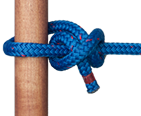
Buntline Hitch: The Buntline Hitch was originally employed to secure buntlines to square sails. It makes a secure hitch to a ring or a pole. A heavy load tends to tighten the hitch and may make it difficult to untie.
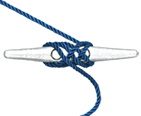
Cleat Hitch (Deck): The Cleat Hitch attaches a rope to a cleat. It is frequently used to secure a mooring line to a dock cleat. It has many other uses, e.g., for dinghy bow lines, and sheets. Linked to this page is a another page about cleating a halyard.
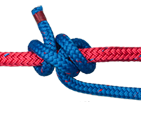
Rolling (Taut Line) Hitch: The Rolling Hitch secures a rope to another parallel rope. It is one of the few knots which can be tied and untied while there is a load and can be adjusted without it being untied. It can take the load while a rope is transferred or secured elsewhere.
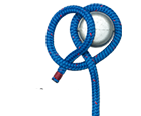
Clove Hitch (Half Hitches): The Clove Hitch is formed by making two Half Hitches. It can be used to attach a rope to a pole or ring. Because it is simple, it is widely known. However, it must be used with caution because it can jam or slip. This page links to a another page showing how to tie the Clove Hitch using the end.

Cow Hitch: The Cow Hitch is two Half Hitches with the second Half Hitch different from the first here tied with the end.
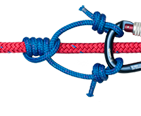
Distel Hitch: The Distel Hitch is a reliable Slide and Grip (friction) Hitch designed to take strain in only one direction. It is tied using a lanyard with a loop at each end secured to a carabiner with a Double Fisherman's bend.

Siberian (Evenk) Hitch: The Siberian, or Evenk, Hitch is a slipped hitch suitable for tying in cold conditions when wearing gloves.

Gnat Hitch: The Gnat Hitch is a simple compact hitch which is relatively easy to untie.

Halyard Hitch: The Halyard Hitch is a very compact knot used to join a halyard and shackle at the head of a sail.
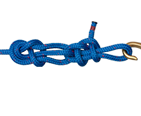
Trucker's Hitch (Lorry, Haymaker's, Harvester's): The Trucker's Hitch is used to secure a load or a tarpaulin down to a hook or other fixed point. It provides a three to one purchase which makes it easier to tighten the rope and reduces the strain on the final knot.
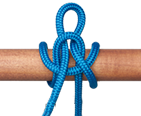
Highwayman's Hitch: The Highwayman's Hitch is a quick-release knot.
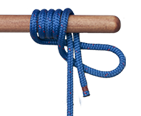
Icicle Hitch (Loop Method): The Icicle Hitch is an excellent slide and grip knot. Here, it is tied by passing a loop over the end of a pole. It is possibly the most secure Slide and Grip knot. This page provides a link to how to tie same knot using the end of the rope.
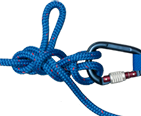
Munter Mule Combination: The Munter Mule Combination provides the Munter hitch for controlled rappelling (abseiling) with the Mule addition to belay the Munter when required. The only equipment required is a locking carabiner.
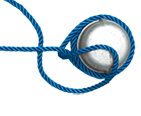
Lighterman's Hitch: The Lighterman's Hitch is a simple robust way of securing a tow line. It can be safely released without risk of jamming.
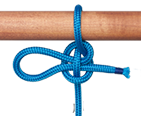
Mooring Hitch : The Mooring Hitch is a quick-release knot for temporarily securing a boat to a post or ring.
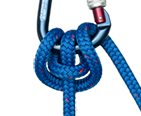
Super Munter Hitch: The Super Munter Hitch provides a secure method of controlling the descent of a heavy load.

Pile Hitch: The Pile Hitch provides a quick and easy way to attach a line to a mooring pole.
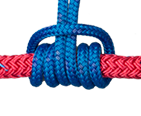
Prusik Knot or Triple Sliding Hitch: The Prusik is a symmetrical Slide and Grip (friction) knot. The same number of turns lie above and below the loop. Load can be taken in either direction.
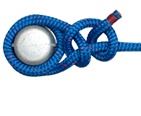
Round Turn and Two Half Hitches: An excellent knot for securing a rope to a post or ring. The initial turns take the load, e.g., of a mooring line during docking. While one hand holds the strain, the knot is then tied with the other.
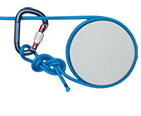
Tensionless Hitch: The Tensionless Hitch secures a rope to a tree or pole by wrapping the rope enough times to ensure that there is no tension in the tail. This end is then finished with a Figure 8 loop and clipped to the standing end with a carabiner.
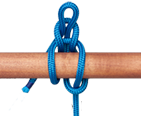
Tumble Hitch : This Tumble Hitch is is a quick-release knot.
Rope Hitches
This page shows a selection of the knots commonly used to make rope hitches. This category includes: Slide and Grip Hitches; Quick-Release Hitches; and, Plain Rope Hitches. Some Fishing Knots function as Slide and Grip Knots. However, limited space prevented them from being included here.
Make a selection from the images above.
